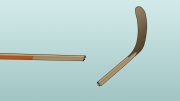Guess who stepped on (another) fire ant colony? Guess who was bitten all over everywhere, went home and stepped on a dying honey bee and had to pull the stinger out of her toe with tweezers, delivering some of the most over used yet charmingly familiar expletives all the while? ’Twas I, your dedicated Puerto Rican wildlife reporter, and I am getting owned by Mother Nature.
This week we’ll be learning about something that hasn’t stung me yet, and hopefully never will: Scolopendra gigantean — the giant centipede.
One of numerous species within the genus Scolopendra, S. gigantea is found in the moist tropics of north and western South America and various islands of the Caribbean, including Puerto Rico. Scolopendra are restricted to humid environments because they breathe using a tracheal system, which consists of a series of chambers that opens to the outside world and through which air circulates to the tissues and organs. They have a dull reddish-brown colouration and always have an odd number of yellowish leg pairs, either 21 or 23.
When Scolopendra get in the mood for love, males deliver sperm to the female on a charming little silk pad. This is because the males have no copulatory organs, poor dears. Once a female picks up the sperm, she will lay her eggs and brood them until the young are able to crawl out into the world on their own.
This hellish centipede can reach around 260 milimetres in length — that’s a quarter of a metre long, folks, which is absolutely terrifying. They are also poisonous — of course! Their venom contains acetylcholine, histamine, serotonin, cardiotoxins and proteases. The venom is not powerful enough to kill a healthy human, but it is seriously painful and can cause swelling, fever, chills and weakness.
They are carnivorous, primarily terrestrial predators that typically eat invertebrates, tarantulas, lizards, frogs, mice and birds. However, the plot thickens when you consider some interesting accounts and mind-boggling adaptations that have been publicized to varying degrees. David Attenborough fans may be familiar with stories of bat-eating centipedes. Sound familiar? That’s Scolopendra gigantea, baby.
These maniacal myriapods have been seen scaling Venezuelan cave walls at night while bats are roosting. They hold on to the ceiling of the cave with their rear legs and dangle their fore legs out into the darkness below. As the bats begin to fly about, the centipede waits until it detects a bat coming close and then quickly reaches out to grab its prey, injecting venom and killing the hapless bat, which it then slowly devours.
In another interesting report by Carptenter and Gillingham, a 200-mm long centipede was observed attacking a 95-mm long marine toad, Bufo marinus, which was introduced to the island of Puerto Rico at some point in the past. The centipede was able to lacerate and puncture the toad’s body cavity, exposing the lung. The centipede then crawled up to the toad’s parotid gland and attempted another bite, at which point the toad released its own toxins from the gland, causing the centipede to drop off and scramble away into the leaf litter as the toad hopped away to toad another day.
In addition to these great little Internet resources I’ve Googled up, I have my own predatorial anecdote — with a twist, of course. Just the other day I found an approximately 190-mm long Scolopendra that was holding an approximately 35-mm long slug underneath its body with its rear legs. The centipede was not eating the slug, however, because its head and mouth-parts were covered in slime, to which gravel, twigs and leaves were becoming horribly stuck. The centipede refused to let the slug go but was vigorously struggling to remove the debris and sticky slime from its head with its fore legs.
Recognizing a great photo-op when I see one, I interfered a little to remove the debris from its head. The centipede continued trying to remove the slime released by the slug when attacked. This went on over a period of about 15 minutes, toward the end of which the slug made its way out from underneath the centipede’s body and quietly made its great escape, slowly slugging away.
When I returned an hour later, they were both gone. I think it’s great that a toad-battling, bat-eating monster of an arthropod can be outdone by the quaintly powerful defence mechanisms of our friends and garden pests, the molluscan slugs. Take that, Scolopendra!





Actually, I think there’s an error here. Other sources say that the average length of this species is a scant 260mm, not 2600. Which is still a bit scary, of course…
yes. there was an error. i wrote that they reach 260mm and there was an editing mistake adding in an extra 0 and then giving the erroneous conversion.
it isn’t physically possible for an animal without lungs to get that big (2.6m) on land…oof.